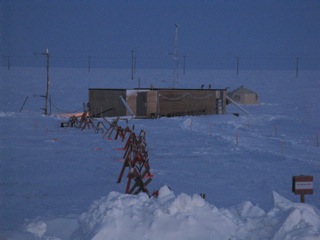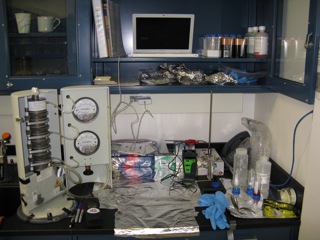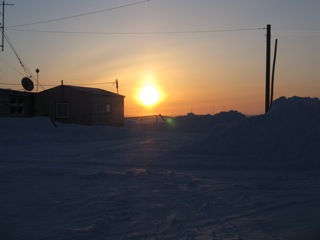The OASIS webcams are now available – check out
You might see me sampling on the camera pointing NE into the clean air and snow sampling sector. I will try to keep smiling
My current research
The OASIS webcams are now available – check out
You might see me sampling on the camera pointing NE into the clean air and snow sampling sector. I will try to keep smiling

Sampling started on time – since my gear had arrived as planned. I have settled into a sampling routine with initially 3 snow samples a day (morning/noon/late afternoon). I have since added a fourth sample in the early morning before sunrise. The dedicated snow sampling site is just behind the tent on the picture. I also take air samples once a day at the snow site and will collect aerosol samples near the prefab buildings with the MOUDI. Additionally I take snow samples for Hg and microbiological analyses (i.e. sterile).
The idea is to monitor VOC concentrations in air and surface snow as it changes over the day. With the additional dark sample I would like to follow the concentrations with the diurnal cycle. As a consequence I would like to investigate, how species move between snow and air and are subjected to photochemistry and microbiological degradation.

I put out the MOUDI yesterday for a first run, but had to take it in in the late afternoon, because of the blowing snow – which started clogging the sampling vent. You can see parts of it on the left – now parked in the lab.
On a related note – I helped launching a balloon yesterday. Find me on the pictures in the OASIS blog. Hint: Second row of pictures, right photo – I am the guy on the far right 😉

I got my gear from the airport yesterday – a whole pallet, which just fitted onto the truck. It’s fun driving on the icy roads with $40,000 worth of gear in the back.
People have been incredibly helpful so far! I got some lab space in a corner and there is always somebody to ask for a tool, advice,… Started setting up and after a long day a beautiful Aurora stretching across the night sky led me home!
I started sampling today (air and snow) and learned a lot about snow stratigraphy, when a French colleague dug a trench and gave us a rundown of its most important features. I sampled the wind packed top layer afterwards.
Btw – you can follow the whole OASIS campaign at http://www.oasishome.net/blog!
I arrived in Barrow yesterday after a series of flights and a long day. I am currently trying to find out, where my equipment is (hopefully not in Anchorage, but in Barrow already) and set up shop in the lab. Once that is done I can start working!
I am at Anchorage airport waiting for my connecting flight to Barrow. So far it’s been smooth coming from Chicago, if a bit tedious. The layover and time to stretch my legs in Seattle was minimal with barely 15 min to connect.
I enjoyed the view as we went North along the inside passage – spectacular glaciers and a very calm sea. It is sunny with -5 degrees Celsius, so quite mild. Barrow will be different.
Flights to Barrow were cancelled for the past few days (check the OASIS Blog!) but for now everything seems to be on schedule. Let’s see …

And here is Barrow on the map!
My first leg on my trip to Barrow is finally over. I made it to Chicago in 6 hours (instead of 2 1/2) due to delays and bad weather at O’Hare. A little bit of snow (how ironic 😉 caused a complete shutdown at O’Hare and quite a few delays on the tarmac (3 hours taxiing!)
My cargo is already in Anchorage and should arrive together with me in Barrow tomorrow night. Chicago – Seattle is next tomorrow morning at 8 am.
The last few weeks have been busy – so busy that I was unable to blog about my stay in Barrow, Alaska, which is about to begin on Sunday!

I will spend about 4 weeks investigating the snow pack and taking samples to analyse for (semi-)volatile organic compounds. For now I have been preparing instruments and other gear, which is on its way to Barrow as well – although stuck in Memphis, TN to clear Customs. It should arrive at the destination on time! I shipped about 350 kg of gear, a lot of pre-cleaned glass bottles, but also a microscope and impactors for aerosol sampling.
Now I am ready to go and I will write a little more about my research programme in the coming days!
I attend a lecture series offered by the Global Environmental and Climate Change Centre (GEC3) at McGill University. Aimed at non-climate scientists, the series elucidates how climate models are set-up, used and interpreted – including their capabilities and limitations.
As a non-modeler this is quit interesting, when it comes to usage of measurement data (like the data I produce) are used in models. Ultimately, I would try some modeling myself in order to obtain a comprehensive picture of how pollutants move between the snow pack and the lower troposphere.
Excellent lecture series! Sometimes a bit basic for my taste (I attended enough seminars on modeling research in the past after all ;-), but still a good opportunity to tie up a few loose ends.

Last week I attended the Arctic Change meeting in Quebec City – an excellent conference organised by ArcticNet with over 900 participants presenting their results on Arctic Research. I gave a talk that was well attended and got quite a few interesting questions – most of the issues discussed I have been thinking of myself for quite a while:
T14. Quantifying the Carbon Balance of Arctic Ecosystems at Various Scales: Gregor Kos & Parisa Ariya, “(Semi)volatile Organic Compounds at Alert, Nunavut – Snow Pack and Boundary Layer Composition”
The meeting had a strong socio-cultural component to disseminate the results among those most affected by the research – the Inuit of the North. Furthermore, awareness was raised that the environment the research takes place in is the home of other people. The need for community outreach and making the results relevant for the local people was stressed often – and rightfully so.